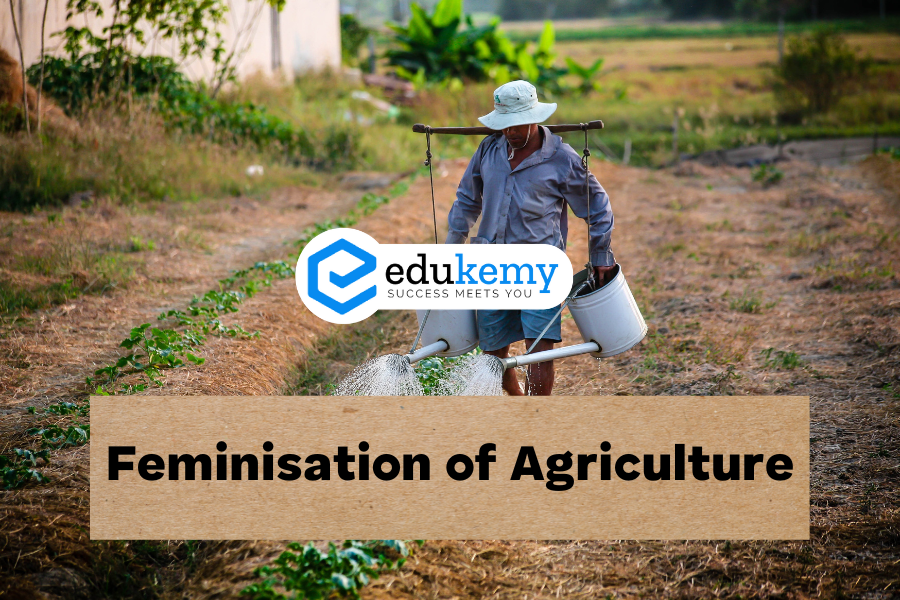
The term “feminization of agriculture” encompasses the increasing participation of women in the agricultural sector, a trend particularly prominent in developing countries. This shift reflects advancements in women’s literacy, skills, and awareness, leading to expanded roles in farm management and labor. However, in the Indian context, the concept takes a different dimension.
- Global Perspective:
- Globally, the feminization of agriculture signifies greater involvement of women in various aspects of agricultural production, distribution, and value addition.
- Indian Context:
- In India, the Economic Survey 2017-18 emphasizes the “feminization” of the agriculture sector due to growing rural-to-urban migration by men. This results in an increasing number of women taking on multiple roles in households and as cultivators, entrepreneurs, and laborers.
- Statistics and Challenges:
- Census 2011 indicates a 24 percent increase in female agricultural laborers between 2001 and 2011.
- Around 98 million Indian women are engaged in agricultural jobs, but the majority (63 percent) work as agricultural laborers on others’ farms.
- Mechanization in agriculture often relegates women to traditional roles with lower wages, such as harvesting, seed sowing, and livestock rearing.
- Women face the burden of household chores, coupled with lower wage rates compared to men.
- Land Rights and Entitlements:
- Women’s lack of land rights denies them access to credit, insurance, irrigation, and other entitlements under agricultural schemes.
- International and National Recognition:
- October 15 is observed as International Rural Women’s Day by the United Nations, recognizing the contribution of rural women to global economic development.
- The Indian government declared October 15 as Rashtriya Mahila Kisan Diwas in 2017, focusing on the challenges faced by women in agriculture.
- Policy Recommendations:
- Policies should aim to enhance women farmers’ access to resources such as land, water, credit, technology, and training.
- Government programs can contribute to this goal by earmarking a significant portion of budget allocations for women beneficiaries, focusing on women’s self-help groups (SHGs), and ensuring their representation in decision-making bodies.
- Empowerment and Representation:
- Capacity-building activities connecting women to micro-credit through SHGs are crucial for empowerment.
- Providing information and ensuring women’s representation in decision-making bodies contribute to a more inclusive and equitable agricultural landscape.
In conclusion, the feminization of agriculture is a multifaceted phenomenon, requiring attention to both global trends and local challenges. Policy interventions that empower women, address land rights and ensure representation can contribute to a more sustainable and inclusive agricultural sector.
Contents
- 1 FAQs
- 1.1 1. What is the feminization of agriculture?
- 1.2 2. Why is the feminization of agriculture occurring?
- 1.3 3. What are the implications of the feminization of agriculture?
- 1.4 4. How does the feminization of agriculture impact rural economies?
- 1.5 5. What policies can address the challenges associated with the feminization of agriculture?
- 2 In case you still have your doubts, contact us on 9811333901.
FAQs
1. What is the feminization of agriculture?
- The feminization of agriculture refers to the increasing involvement of women in agricultural activities, either due to economic necessity, rural out-migration of men, or changing gender roles.
2. Why is the feminization of agriculture occurring?
- Several factors contribute to the feminization of agriculture, including urbanization, male out-migration for non-agricultural employment, and greater access to education and resources for women. Additionally, women often take on agricultural responsibilities when men leave for urban areas for better opportunities.
3. What are the implications of the feminization of agriculture?
- The feminization of agriculture can lead to increased productivity and innovation in farming practices. However, it also highlights gender disparities in access to resources, such as land ownership, credit, and agricultural extension services. Addressing these disparities is crucial for achieving gender equality and sustainable agricultural development.
4. How does the feminization of agriculture impact rural economies?
- Women’s participation in agriculture contributes significantly to rural economies by increasing food production, household income, and community development. However, their contributions are often undervalued and unrecognized, leading to persistent poverty among rural women and their families.
5. What policies can address the challenges associated with the feminization of agriculture?
- Policies that promote gender equality in access to land, credit, technology, and extension services are essential for supporting women farmers. Investing in women’s education, training, and leadership development can empower them to become more effective agents of change in agriculture and rural development.
In case you still have your doubts, contact us on 9811333901.
For UPSC Prelims Resources, Click here
For Daily Updates and Study Material:
Join our Telegram Channel – Edukemy for IAS
- 1. Learn through Videos – here
- 2. Be Exam Ready by Practicing Daily MCQs – here
- 3. Daily Newsletter – Get all your Current Affairs Covered – here
- 4. Mains Answer Writing Practice – here

